


|

|
Trash Screen in Section 9 |
| Ed Murtagh April 10, 2004 |
Update October 23, 2004 |
Update May 27, 2006 |
Update November 5, 2007 |
Update April 13, 2010 |
Trash is one of the most pervasive problems in urban waterways such as Sligo Creek. Much of the trash in Sligo Creek is washed from the street and into the creek with the stormwater. It is not unusual to clean the creek and have it lined with trash again after the next rainstorm. Cleaning up half a mile of headwaters stream takes at least 2 hours. Trash screens that collect stormwater borne trash at a few key locations along the creek can save a lot of time and effort. One of the recommendations of the Sligo Creek Trash Reduction Plan prepared by John Galli and Peter Guillozet in 2000 includes installing trash-catching devices such as chain link fences near the end of stormwater pipes. According to the Galli/Guillozert plan, chain link fences are inexpensive and may capture a significant portion of the floating trash. One of the main disadvantages is that this strategy will require frequent inspections and trash removal (perhaps after every heavy rain). A trash screen, though inexpensive, will require a volunteer to regularly monitor and maintain the site. The screen can also block the water flow if not maintained. Along the creek there are numerous naturally occurring "trash screens" that do not cause significant water blockage, so we don't anticipate that this will be a serious problem.
The Litter Committee saw that this was a simple yet potentially effective means of keeping the creek trash free. The Litter Committee was unable, however, to find any chain link fence screens in use. The Committee decided that oSC would request that the Parks install one pilot trash screen at the headwaters of Sligo Creek and that FoSC would maintain, monitor, and evaluate the trash screen. In the fall of 2003, FoSC, AWS and the Park Manager met at the site and discussed the project. The Park Manager agreed to install a trash screen. In March 2004 the trash screen was installed.
| Photo of newly installed trash screen, March 2004 |
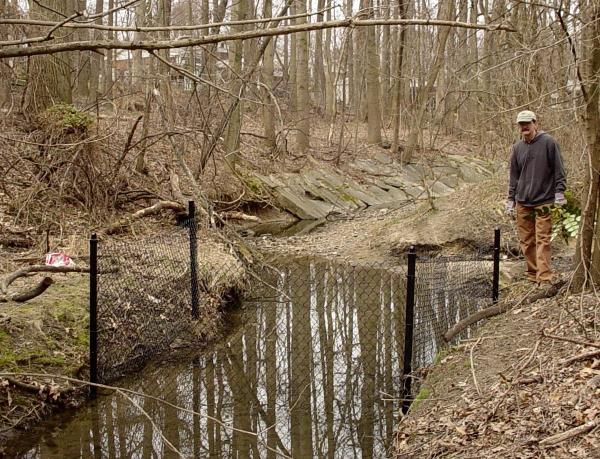 |
Soon after the trash screen was installed, I thoroughly cleaned the creek downstream of the screen and started periodically monitoring the trash levels in the creek. My initial feeling is that the screen is fairly effective. It has been my observation that most of the trash that gets in the creek in our section of the park enters with the stormwater after a heavy rain. Below is a photo of the trash collected after a moderate, but sustained rain. The screen captured about 90% of the large pieces of trash (plastic bottles, bags, Styrofoam products, aluminum cans).
| Overhead view of screen after two days of light to moderate rain, April 3, 2004 |
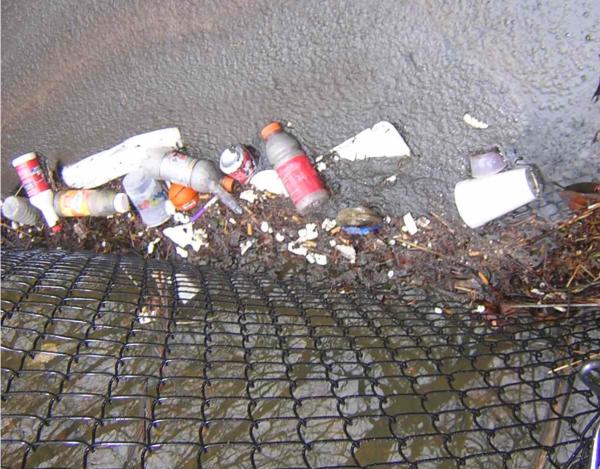 |
I have also been finding that the force of the water flow during rainstorms is enough to stretch the fence linkages. This causes the fence to sag in the middle. Because the metal gauge is light, it is fairly easy to stretch the fence back into shape. This problem could be addressed with a heavier gauge fence links. I also noticed that there has been some minor scouring under the screen. About 6 inches of sediment under the screen has been scoured away. I assume that water velocity increases when the water flow through the chain link fence becomes obstructed with the leaves/debris mentioned above.
I was recently talking to one of the engineers with the Stormwater Facility Maintenance Program at Montgomery County Department of Environmental Protection (DEP). He mentioned that he was by the University Blvd Stormwater management ponds (about 3/4 mile downstream of the trash screen) recently, and he was surprised by how they were relatively trash-free. That confirmed to me my observation that the trash screen and our twice a year clean up workdays have made a difference in Upper Sligo Creek.
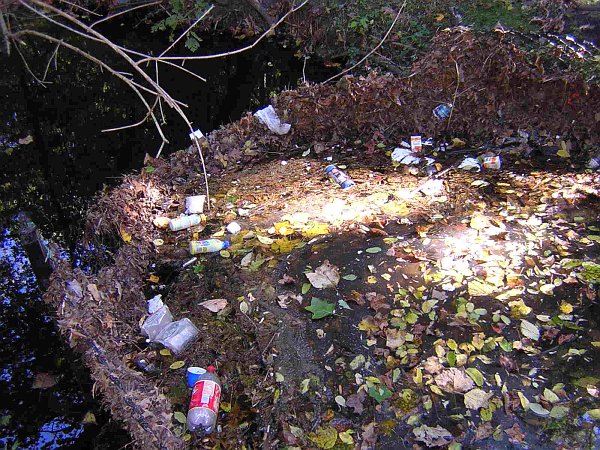
May 2006 Update
It has been over two years since the trash screen was installed. The screen has been performing well with only minor maintenance required - re-stretching the chain link fence into its original shape every few months, clearing away larges branches occasionally, and re-pounding the four posts into the stream bed once or twice a year. I notice that if we have heavy rain on our community's Trash Pick Up Day, there will be a lot of trash captured in the screen.
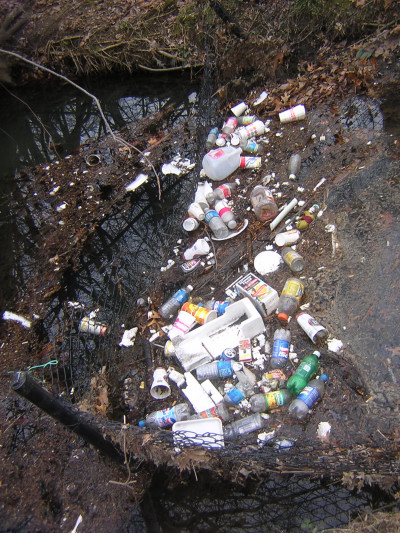
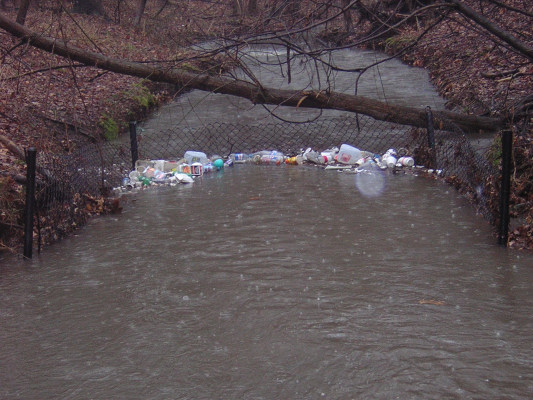
November 2007 Update
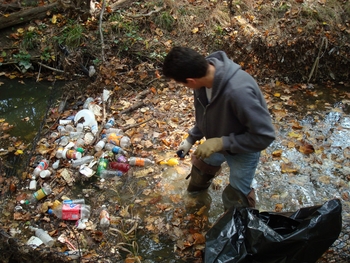 The trash trap has been functioning for about three and a half years now. During that time the trap has captured countless bags of trash. During 2007 we have had an extended drought, so we have not had to clean out the trash often. Today was the first time this fall that the trap needed to be cleaned out. Today's haul included 18 beer cans, which are now going to be recycled rather than going downstream and getting buried in sediment. Recycling 18 aluminum cans saves about 5 kWh or energy; enough energy to power a typical home for 2 or 3 hours. Of course there were also many, many plastic bottles.
The trash trap has been functioning for about three and a half years now. During that time the trap has captured countless bags of trash. During 2007 we have had an extended drought, so we have not had to clean out the trash often. Today was the first time this fall that the trap needed to be cleaned out. Today's haul included 18 beer cans, which are now going to be recycled rather than going downstream and getting buried in sediment. Recycling 18 aluminum cans saves about 5 kWh or energy; enough energy to power a typical home for 2 or 3 hours. Of course there were also many, many plastic bottles.
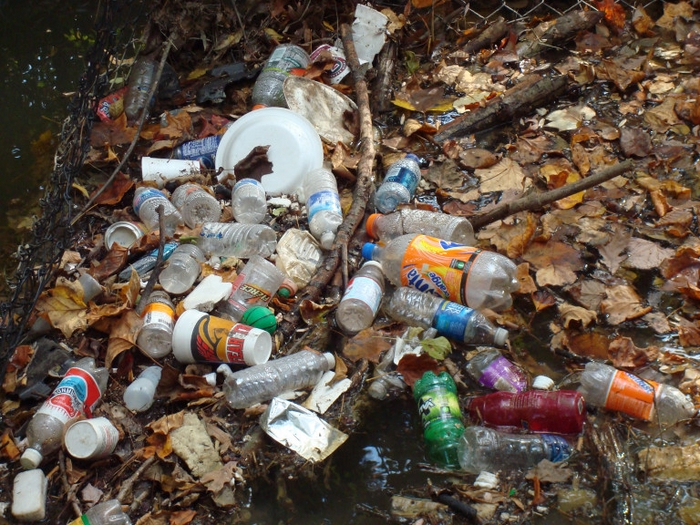
One thing that I have noticed over the past three and a half years is the large amounts of polystyrene (Styrofoam) that gets washed into Sligo Creek every time it rains. Most of the polystyrene breaks up into a multitude of tiny pieces and is difficult to remove. Not only is this a permanent visual blight on creek, but it is ingested by aquatic wildlife, frequently causing death. The polystyrene industry says it is not practical to use biodegradable alternative. That may be the case, but it would be nice if the industry group would take some responsibility by helping clean up the mess.
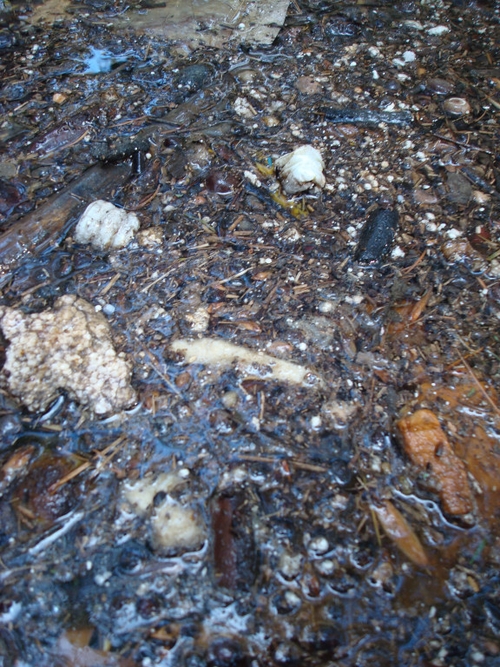
After 6 years the trash trap is still functioning, still capturing lots of plastic bottles, aluminum cans, plastic bags and other pieces of trash. During these 6 years, it has survived a hurricane and some minor vandalism. Minor maintenance is still required. The photo above was taken March 2010. Unfortunately, the trash keeps flowing down Sligo Creek and into the Northwest Branch and the Anacostia River. The new Montgomery County MS4 stormwater permit requires Montgomery County to implement the provisions of the 2013 Trash Free Potomac River Treaty, hopefully, finally putting the trash trap out of business. During the past six years, I have become aware of how prolific plastic bottles have become in our streams. Attempts to pass a bottle bill in Maryland, however, have failed. The Bag Bill, similar to the one passed in the District of Columbia last year, will probably not pass this year in Maryland. After the DC Bag bill was implemented, there was a dramatic increase in the use of reusable bags and an equally dramatic decrease in the use of plastic bags. Perhaps if the politicians got out more and saw firsthand the litter in our natural areas, they would not be so easily swayed by lobbyists to vote against these bills.